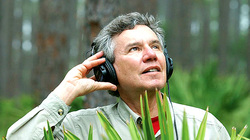|
Joel Sartore has produced more than 30 stories from around the world as a freelance photographer for National Geographic magazine. He is an author, speaker and teacher who captivates audiences with his funny and inspiring adventures. His images show a world worth saving.
For many of Earth’s creatures, time is running out. Half of the world’s plant and animal species will soon be threatened with extinction. The goal of the Photo Ark is to document biodiversity, show what’s at stake and to get people to care while there’s still time. More than 1,800 species have been photographed to date, with more to come. Definitely is one of my favorites photographers, I love all the picks he took for this project I hope you enjoy his work as much I did ! Photo: Female African elephant (Loxodonta africana) at the Cheyenne Mountain Zoo.
0 Comments
There are several career paths you can follow as a biologist, including these:
Research: Research biologists study the natural world, using the latest scientific tools and techniques in both laboratory settings and the outdoors, to understand how living systems work. Many work in exotic locations around the world, and what they discover increases our understanding of biology and may be put to practical use to find solutions to specific problems. Health care: Biologists may develop public health campaigns to defeat illnesses such as tuberculosis, AIDS, cancer, and heart disease. Others work to prevent the spread of rare, deadly diseases, such as the now infamous Ebola virus. Veterinarians tend to sick and injured animals, and doctors, dentists, nurses, and other health care professionals maintain the general health and well being of their patients. Environmental management and conservation: Biologists in management and conservation careers are interested in solving environmental problems and preserving the natural world for future generations. Park rangers protect state and national parks, help preserve their natural resources, and educate the general public. Zoo biologists carry out endangered species recovery programs. In addition, management and conservation biologists often work with members of a community such as landowners and special interest groups to develop and implement management plans. Education: Life science educators enjoy working with people and encouraging them to learn new things, whether in a classroom, a research lab, the field, or a museum. Colleges and universities: Professors and lecturers teach introductory and advanced biology courses. They may also mentor students with projects and direct research programs. Primary and secondary schools: Teaching younger students requires a general knowledge of science and skill at working with different kinds of learners. High school teachers often specialize in biology and teach other courses of personal interest. Science museums, zoos, aquariums, parks, and nature centers: Educators in these settings may design exhibits and educational programs, in addition to teaching special classes or leading tours and nature hikes. New directions in biological careers: There are many careers for biologists who want to combine their scientific training with interests in other fields. Here are some examples: Biotechnology: Biologists apply scientific principles to develop and enhance products, tools, and technological advances in fields such as agriculture, food science, and medicine. Forensic science: Forensic biologists work with police departments and other law enforcement agencies using scientific methods to discover and process evidence that can be used to solve crimes. Politics and policy: Science advisors work with lawmakers to create new legislation on topics such as biomedical research and environmental protection. Their input is essential, ensuring that decisions are based upon solid science. Business and industry: Biologists work with drug companies and providers of scientific products and services to research and test new products. They also work in sales, marketing, and public relations positions. Economics: Trained professionals work with the government and other organizations to study and address the economic impacts of biological issues, such as species extinctions, forest protection, and environmental pollution. Mathematics: Biologists in fields such as bioinformatics and computational biology apply mathematical techniques to solve biological problems, such as modeling ecosystem processes and gene sequencing. Science writing and communication: Journalists and writers with a science background inform the general public about relevant and emerging biological issues. Art: All the illustrations in your biology textbook, as well as in newspaper and magazine science articles, were created by talented artists with a thorough understanding of biology. Source: http://www.aibs.c  Foto: bbc Foto: bbc Bernie Krause ha dedicado gran parte de su vida ha obtener miles de registros acústicos en distintos rincones del planeta. Krause, autor del libro "La gran orquesta animal", es quien acunó el término "biofonía" para describir sus grabaciones en diversos ecosistemas. Estos "paisajes acústicos" le han permitido demostrar el impacto en la fauna de alteraciones en su hábitat, aunque a simple vista nada parezca haber cambiado. |
Blog Archive
|

 RSS Feed
RSS Feed
